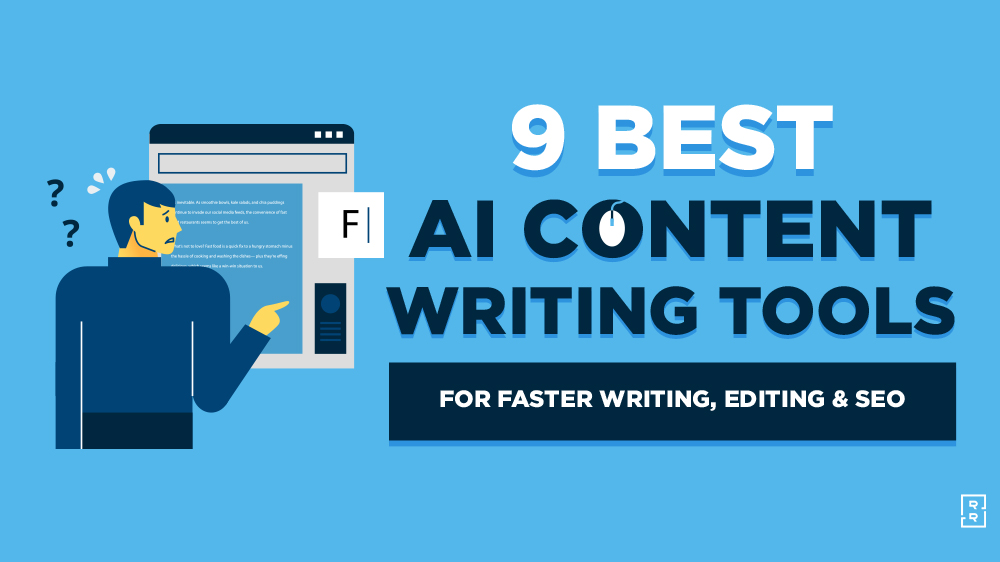Over the past couple years, AI writing tools have skyrocketed in popularity. No doubt, you’ve also tried ChatGPT (by OpenAI), too.
As a busy blogger, you’re likely on the lookout for blogging tools that will speed up your content marketing progress. Using a smart AI tool that can write for you (or at the very least, help streamline your writing process with things like a paragraph rewriter) might sound like the stuff of science fiction… but it’s already our reality.
If you’ve never tried an AI writing tool, you might only have a vague idea of what these pieces of software are—and how they work.
Before I get to my list of the best AI content writing tools, we’ll take a quick look at what exactly these tools are and how bloggers should be utilizing them in their content creation & editing processes today.
If you want to go straight to specific tools instead, here’s a list of everything I cover in this article. Just click on the name of a tool to jump to its section:
9 Best AI Writing Tools in 2025 (Write, Edit & SEO Boost Your Blog)
To keep things simple for you, I’ve kept this article focused on the very best 9 AI writing tools out there … but I’ve also included a bunch of bonus tools that can be incredibly helpful for specific content writing tasks, like SEO optimization and editing.
- RightBlogger
- Jasper
- Writesonic
- Copy.ai
- ChatGPT
- Anyword
- AI Writer
- INK Editor
- Rytr
Bonus AI writing tools we touch on (for specific use cases): GrowthBar, Surfer SEO, Frase, Article Forge, Grammarly, WordTune
Disclosure: Please note that some of the links below are affiliate links and at no additional cost to you, I’ll earn a commission. Know that I only recommend products and services I’ve personally used and stand behind. When you use one of my affiliate links, the company compensates me, which helps me run this blog and keep my in-depth content free of charge for readers (like you).
Try RightBlogger: My 80+ Hand-Crafted Tools for Content Creators

Join 10,397+ creators, bloggers, marketers, writers, freelancers & entrepreneurs in using my very own kit of powerful tools for content creation: RightBlogger. You’ll unlock 80+ blogging, SEO, marketing, sales and productivity-focused tools to create content faster & more effectively today.
What Are AI Writing Tools?
AI stands for “artificial intelligence.” It’s not about the rise of the machines—computers haven’t achieved sentience (yet). Instead, this is all about machine learning: software that’s programmed with algorithms allowing it to learn on its own, over time.
AI has wide-reaching implications in a range of industries, but in the past few years, it’s become particularly significant in the world of content writing and blogging. With the proliferation of AI writing tools that can automate every aspect of your content creation process, you can leverage everything from AI writing assistants to AI article writers, ad copy generators, plagiarism checkers, brainstorming tools and so much more..
So, there’s a good chance that you’re already familiar with AI content writing tools (even if you haven’t started a blog yourself… you just might not know it yet.
For instance, if you use Gmail, you’ve probably already come across Google’s “Smart Compose” feature. This is when Gmail offers you an automatic writing suggestion when you’re part-way through typing a sentence, like this:


Gmail doesn’t just offer generic suggestions, either. By default, Gmail offers personalized suggestions that are tailored to your writing style. That’s machine learning in action.
You can also see the Smart Compose feature in action in Google Docs. In fact, the start of this section used that very feature. When I was partway through the first sentence, Google suggested a couple of words:


You might also have used an AI writing assistant like Grammarly, to help you write clear, concise content that’s grammatically accurate.
Of course, many AI writing tools can go much further than this simple example. Given a prompt—like the title of a blog post—they can produce paragraph after paragraph of original content. You could use them to break through writer’s block or to save money outsourcing content writing to freelancers. Check out my free keyword research tool to see how we’re blending AI into the keyword research process.
9 Best AI Writing Tools for Bloggers in 2025 (Write, Edit & SEO Boost Your Blog)
I’ve picked some of the best AI writing tools to use when creating content for your blog—and striving to optimize for SEO friendliness.


RightBlogger was built to be the complete AI-powered content creation suite of 80+ tools for content creators. It’s the toolbox I wish I had when I first started blogging. If you want to take your content creation process to the next level—RightBlogger will help you write faster & more SEO-friendly content for your blog.
By leveraging the power of AI, RightBlogger makes it easier than ever to craft engaging, high-quality content in the click of a button. Here are just a few of the features that make RightBlogger the ultimate AI-powered content creation tool for bloggers:
- Automated Content Creation: Generate high-quality content quickly and easily with RightBlogger’s AI-powered content creation tools.
- Intuitive Content Editor: The intuitive content editor makes it easy to customize your content to make it truly your own (no coding or detailed ChatGPT-style prompt writing required!).
- SEO Optimization: Optimize your content for search engine success with the SEO Tools and the knowledge that every tool is built with an emphasis on generating content that’s designed to rank well in search engines.
Take a Look at RightBlogger’s AI Writing Tools
What kinds of AI writing tools can you expect to unlock inside of RightBlogger? I’ll run you through some of my absolute favorites.
Here are just a few the 80+ tools you’ll get unlimited access to inside RightBlogger:
- Blogging: Article Writer, Listicle Writer, Introduction, Paragraph, Conclusion, Outline Generator, FAQ Writer, List Generator, Rewriter Tool (Paraphrasing Tool), Shortener, Expander
- Research: Smart Suggest (get blog post ideas based on your blog URL), Blog Post Idea Generator, Headline Generator, Keyword Research Tool (unlimited), Keyword Cluster
- Marketing: Meta Title, Meta Description, Email Subject Line, Cold Email, Call-To-Action, Product Description, Ad Copy, AIDA, Feature/Benefit/Outcome
- Video Creators: YouTube Video to Blog Post, Video Title, Video Description, Video Script Outline, Short Form Ideas
- Social Media: Tweet/X Post Ideas, LinkedIn Post, Facebook Post, Pinterest Pin,
- Productivity: Chat, Summarizer (generates summaries of text), Content Filler, Explain Like I’m Five
Let’s take a look at RightBlogger in action. The Article Writer tool can create an entire blog post for you from just a keyword. Optionally, you can tweak the tone, add images and links, and even give the AI special instructions.
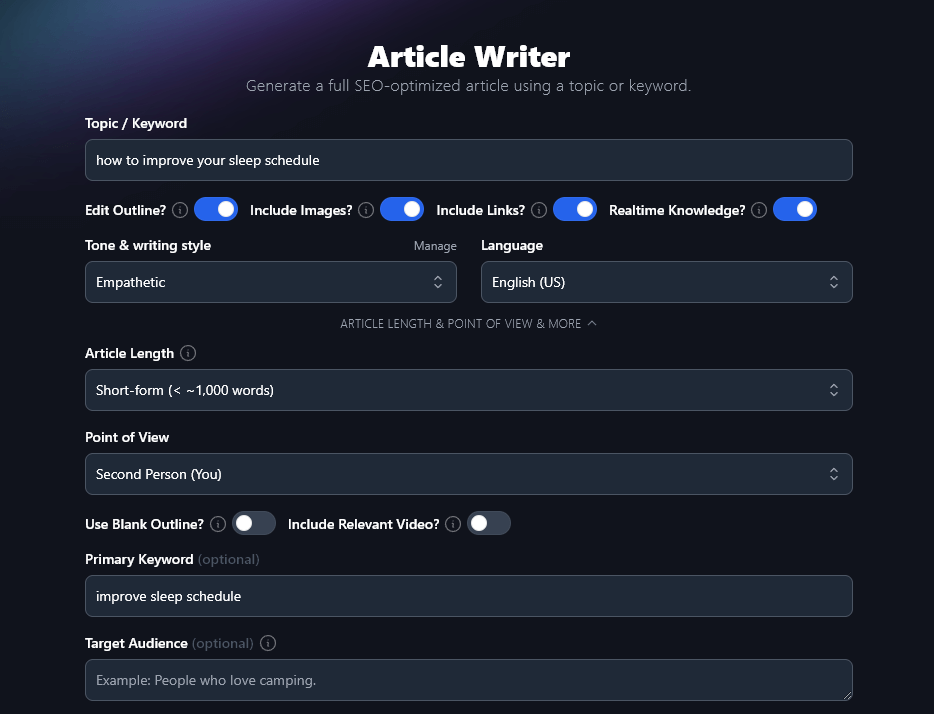

If you opted to edit the outline, you’ll see an outline next. You can add, edit, remove, or move around the subheadings in the outline.The outline editor also allows you to paste an outline from any other format to have it converted to work in the RightBlogger editor (great if you have an outline from an editor you want to use).
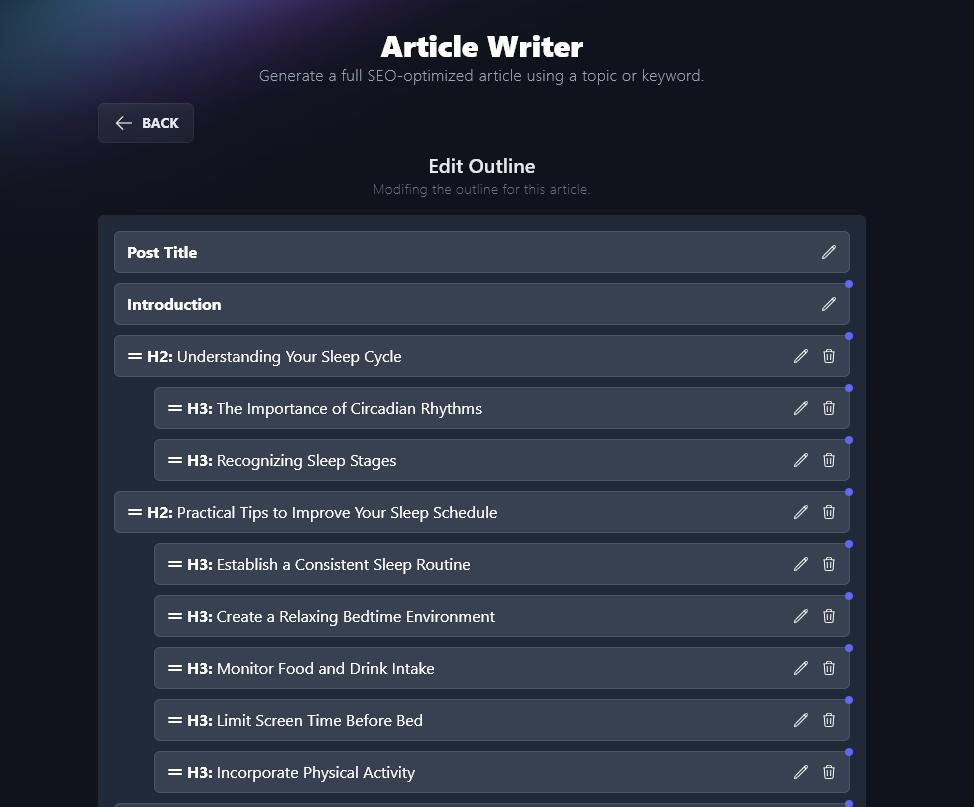

Once your outline is ready, click the “Generate Article” to get the AI to draft the post. This may take a minute or two for longer posts. You’ll see the content appear before your eyes!
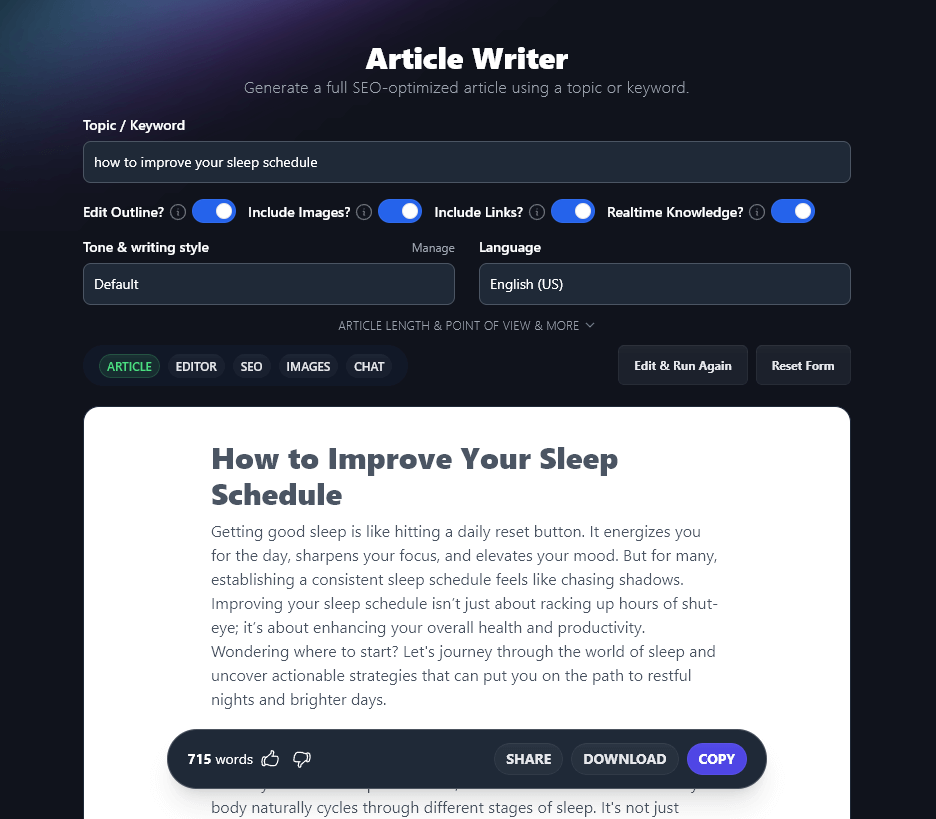

RightBlogger is adding new AI content tools into the platform every week—plus subscribers have the opportunity to suggest new tools & features, almost all of which get implemented within a few weeks. Even cooler, you can 1-click send your content straight to your blog using our AI Article Writer for WordPress.
Let’s take a look at some pros and cons, compared with other AI tools.
Pros of RightBlogger
- You can create a 100% free account and use all tools with a monthly word limit.
- RightBlogger generates everything from short-form content like paragraphs, introductions & conclusions, up to entire long-form blog posts (up to 2,500 words in length) from a single prompt. You can string together even longer blog posts by creating custom outlines. The blog post writer in RightBlogger also includes the ability to set a primary keyword, images, internal links, and external links.
- Access RightBlogger chat, which can generate AI images, fetch real-time data, and assist you in writing content using your own prompts.
- You can select from 15+ pre-created tones of voice, or you can set up to 5 different completely customized MyTone options to produce AI-generated content that’s a seamless match for your existing brand voice through blog posts, social media, and so on.
- At the $29.99/mo price point for unlimited use, it’s one of the most affordable AI content generation tools on the market.
- There’s no usage limit for the full RightBlogger plan, which means you can go absolutely nuts generating as much content as you want.
- You can use RightBlogger to write content in 112+ different languages today (with more support coming soon).
- RightBlogger includes an unlimited use Keyword Research Tool & Keyword Cluster Tool, while no other popular AI-powered content generation tools offer these kinds of features.
- There’s a Feedback forum for RightBlogger where you can suggest new tools (or new features for existing tools). We’ve already created loads of tools based on what users have asked for here.
Cons of RightBlogger
- Today, RightBlogger offers content generation in 109 different languages, with additional language support coming soon, but our platform itself is only accessible in English.
- Free accounts on RightBlogger are limited in the amount of usage per month, so you’ll have to subscribe to really get the most out of the 80+ AI-powered tools inside RightBlogger (we do offer a no questions asked refund & cancellation policy).
- Today, we don’t (yet) have a built-in integration with WordPress for RightBlogger (we do have a RightBlogger Chrome Extension), though the WordPress plugin will soon be in development, to help you generate content wherever you work including inside: Google Docs, WordPress and more.
Who is RightBlogger Best For?
RightBlogger is ideal for new bloggers and small to medium online businesses, because it’s so affordable. It’s also a great option if you’re not super-techy, or you’re new to AI, as the tools/templates are already made for you. There’s just one pricing plan ($29.99/month) for unlimited use so you can experiment with creating as much content as you like!
Things we’ve heard from users:
- “When I opened Rightblogger for the first time, I thought: I’m dreaming! So many useful features in one tool!” – Sandra Megahed
- “RightBlogger is beating Jasper in every way” – Peter Kanai
- “RightBlogger has been the best find of my literary life” – Albert
RightBlogger is also a fantastic option if you want to go beyond using AI for writing content and AI tools like video script generators, productivity tools (like our AI summarizer), and more. It’s a comprehensive suite of AI tools designed to perfectly fit the needs of bloggers and business owners.
Pricing
RightBlogger costs $29.99/mo for the unlimited plan (billed monthly). The annual subscription is $299, so you essentially get 2 months free on this plan.
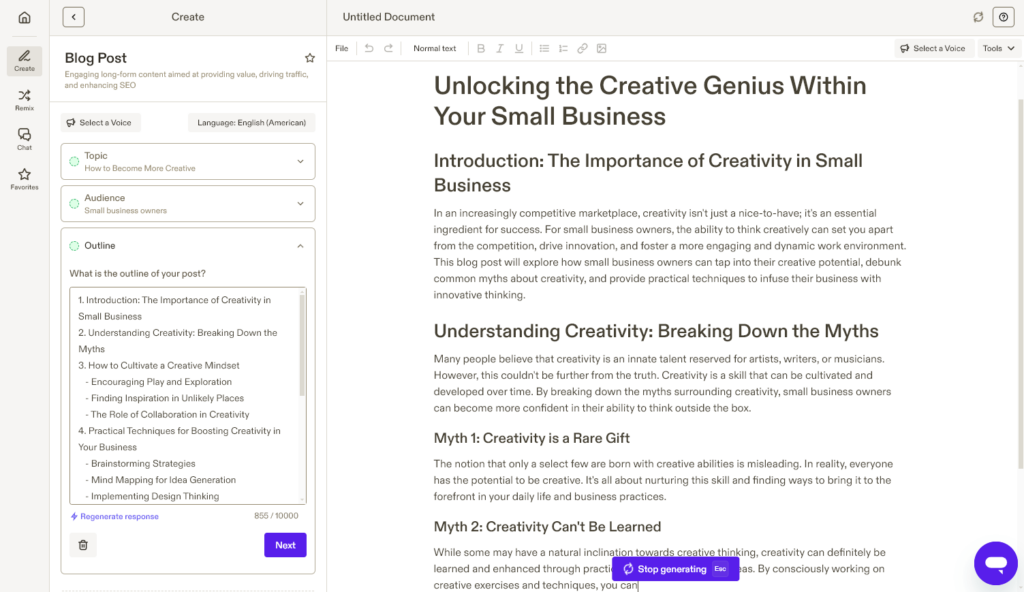

If you’re looking for an AI writing tool to create long-form content like blog posts, Jasper (formerly called Jarvis) is has been around in the AI tools space for a couple of years now. You can try it out for free for 5 days and up to 10,000 words.
If you’re working alongside a team of content creators, Jasper AI is particularly well geared up to your needs. You can have multiple users, so that everyone can work on content together.
There are a bunch of pre-built templates (how many you get access to depends on your chosen pricing plan) to create specific types of content, such as YouTube scripts, Instagram captions, and LinkedIn content. You can even use Jasper for eCommerce content like product bullet points. Jasper also integrates with Surfer to optimize your content for search engines, too (but you’ll need to pay for both tools).
Now, let’s talk about some pros and cons of this AI writing tool:
Pros of Jasper
- Jasper can create a wide range of different types of blog post, including case studies, comparison posts, listicles, thought leadership articles, and more.
- You can use Jasper to write content in 25+ different languages.
- There’s a Jasper Chrome extension so you can use Jasper wherever you write: that includes making easy integrations with Google Docs, WordPress, and more.
- Jasper learns as you use it, meaning that your content will gradually have more of your natural personality and voice over time.
Cons of Jasper
- Jasper costs more than alternatives like RightBlogger and ChatGPT and the free trial is limited to just 7 days. You’ll need to give your credit card info to access the trial, too.
- You only get a set number of words each month—so if you give Jasper a prompt that doesn’t result in useful content, you’ve used up part of your allowance.
- You’ll need to pay extra if you want plagiarism detection (provided through a partnership with the popular plagiarism checker, Copyscape).
Who is Jasper Best For?
If you already have Surfer, Jasper works seamlessly with it … though keep in mind you’ll need to pay for both tools! Jasper is a well-established tool that produces high-quality AI content, so it’s a good fit for larger businesses that can budget for a premium AI option.
Pricing
Jasper costs from $49/mo ($39/month billed annually) – this allows you to generate up to 20,000 words/month.
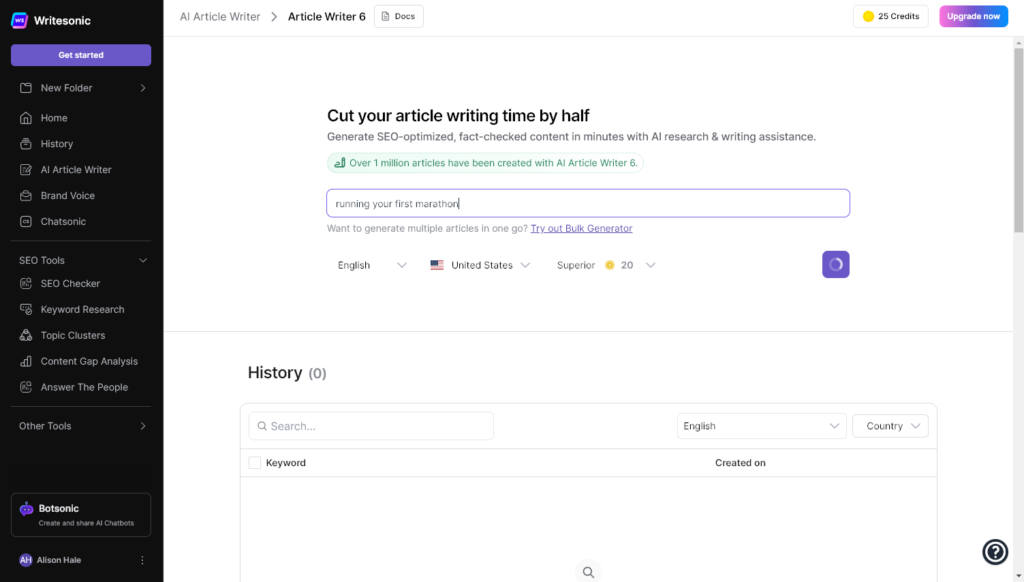

Writesonic thrives on the SEO front as an AI writing tool, to help automate creating SEO-optimized content. You can use it for the whole of your blog writing process—from getting ideas to creating an outline to writing a full article.
Writesonic can produce multiple alternatives for you to choose from, making it easier to come up with a finished piece that fully reflects your own style. For instance, when you’re creating blog posts, you can choose between different outlines.
The article writer also has lots of other options to fine-tune your results:
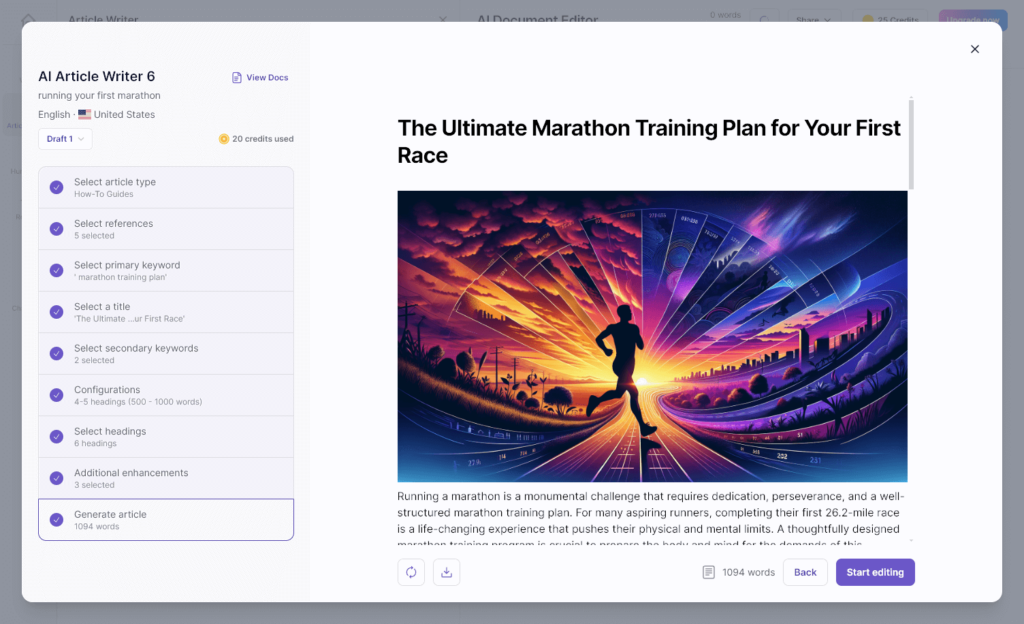

As well as writing blog posts and articles, you can use Writesonic’s AI Article Writer to produce marketing content (such as sales emails) and even longer-form content like ebooks. It’s also able to handle things like SEO-optimized product descriptions, ad copy for social media posts, and landing page copy.
Writesonic also offers an AI chatbot called Chatsonic. If you just want to use Chatsonic, you can sign up for that at a slightly lower fee … but this doesn’t include any templates.
Pros of Writesonic
- Writesonic offers lots of different options for a wide range of use cases, including a range of types of blog posts.
- Writesonic will propmt you to choose a primary keyword, listing difficulties and volumes right there in the article creator. It also encourages you to choose secondary keywords.
- There’s a “Make your own AI” feature that lets you “train Writesonic to write exactly what you want.”
- Writesonic is significantly cheaper than Jasper and you don’t need to enter any credit card details for the free plan.
- You also get access to Photosonic to create AI images, which can be a great way to enhance your content.
Cons of Writesonic
- If you want to use the more advanced tools, you need to use up your monthly credits—meaning that you could end up running out of credits or spending extra on content that isn’t suitable for your needs (especially while you’re getting to grips with the system).
- If you want to create long-form articles in one step, you’ll need to upgrade to a paid plan. You can’t use the instant long-form article writing feature on the free plan.
- Only the AI Article Writer 4.0 is available for unlimited usage on the cheaper plan. You’ll need to use up credits if you want to use the 5.0 and 6.0 versions.
- Writesonic doesn’t have native integrations (though you can connect your account to Zapier and make workflows with other writing platforms you use in your content creation process).
Who is Writesonic Best For?
Writesonic is a great option if you’re on a tight budget and even has a free plan (though this only gives you 25 credits total, so in practice it’s more like a free trial). The standard tools are available for unlimited use on the cheapest plan, so if those are good enough for your content needs, Writesonic could be the right choice for you.
Pricing
WriteSonic costs from $20/month ($16/month when billed annually)—this gives you unlimited content generations using standard templates, plus 50 monthly credits to use advanced templates.
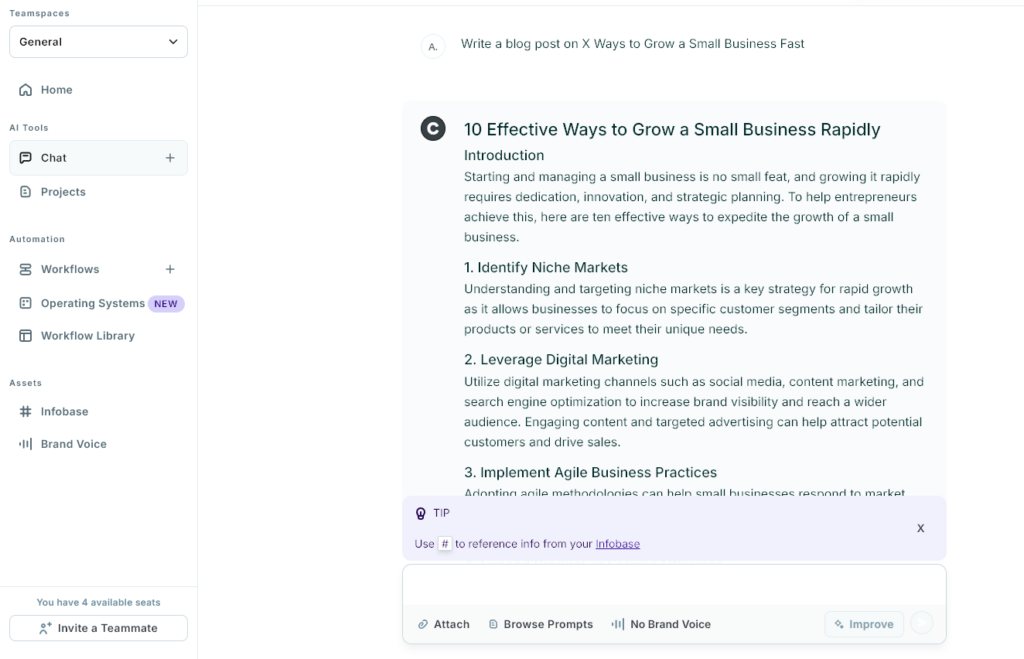

Copy.ai is an AI writing software platform originally designed for creating AI-generated content like blog posts and marketing copy (like emails). It has plenty of different tools and templates to produce all sorts of other types of content too.
Over the past year, Copy.ai has become more focused on sales and marketing teams and GTM (go-to-market) strategies. It’s still a good option for smaller businesses and bloggers and has an easy and intuitive Chat interface, as well as the ability to create Workflows that can integrate with other tools.
There are pre-written prompts you can use, though we found those quite limited. You’d likely need to add more details to the prompts to get good results.
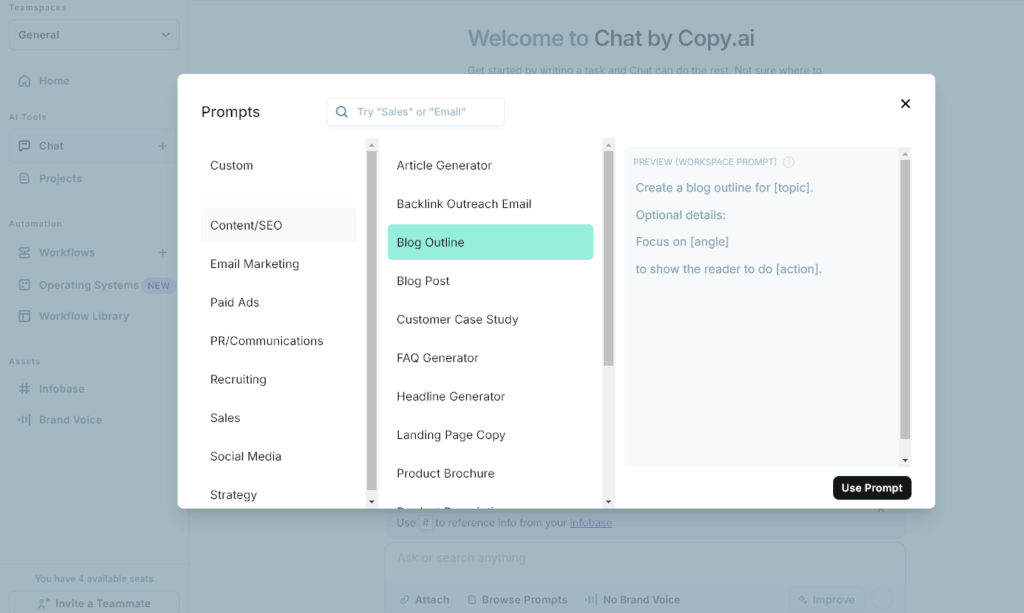

Pros of Copy.ai
- Unlike Jasper and Writesonic, Copy.ai has a truly free plan, allowing you to produce up to 2,000 words per month. This plan includes access to features like Brand Voice and Infobase, plus a 7-day free trial of the pro plan.
- With the Starter plan, there’s no limit to the number of words you can produce through Chat. This means you can experiment with lots of different ideas and prompts, risk-free.
- You can create AI-generated content in 25+ different languages on the pro plan. (The free plan only offers English content.)
- Copy.ai gives you multiple options to choose from as you create content: you can copy these, save them, remove them, or ask CopyAI to give you more content like this.
- The interface and workflow is easy to get to grip with, even if you’ve never used an AI copywriting tool before.
Cons of Copy.ai
- Copy.ai doesn’t have built-in templates (though it does offer pre-created Workflows) so you’ll need to use prompts within the Chat feature to create different types of content. There is a prompt library to help you, however.
- If you want to use Workflows, you need the Advanced plan, which costs $249/month—out of reach for many small businesses.
- The starter plan only gives you 1 user, so it’s not ideal for teams.
Who is Copy.ai Best For?
Copy.ai is highly focused on big companies with sales and marketing teams who are looking to improve their GTM (go-to-market) operations. It’s not a very good fit for individiual bloggers or small online businesses due to its price.
Pricing
Copy.ai costs from $49/month ($36/month billed annually) for unlimited words.
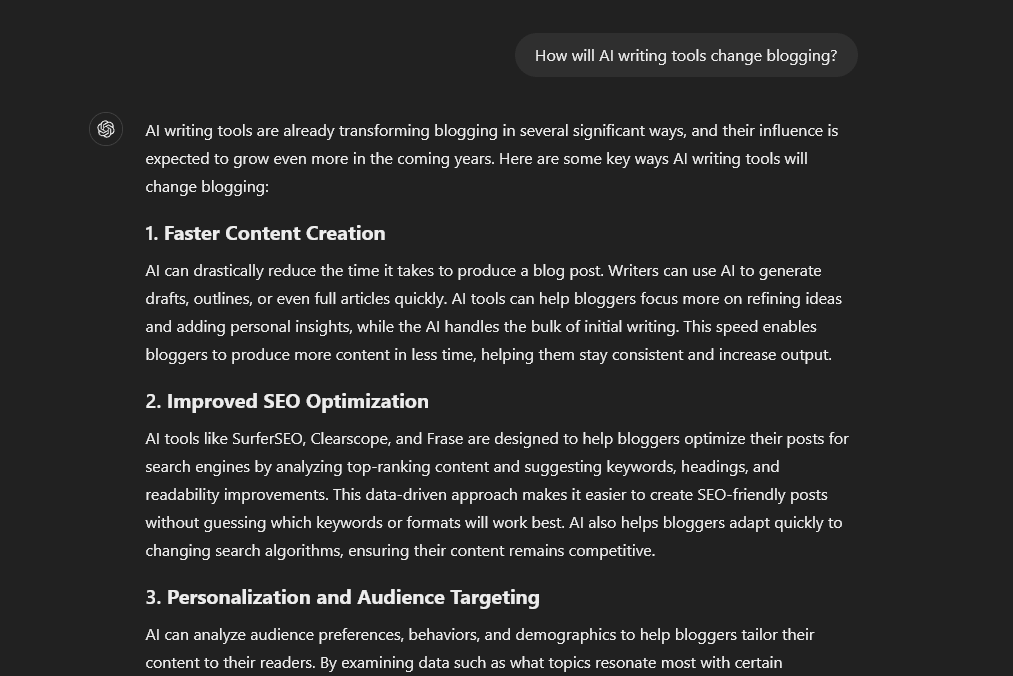

The first AI tool you ever heard of was most likely ChatGPT, a totally free and very easy-to-use piece of AI writing tool from OpenAI (an AI research and development company). In fact, OpenAI’s API is what powers the backend functionality of many AI writing tools on the market today.
ChatGPT interacts in a conversational way, with a dialogue format. You can type in any kind of prompt or request you want—meaning ChatGPT can produce all sorts of types of content. You could ask it for content ideas, titles, an outline or content brief, an introduction, content in a particular tone… as well as product descriptions, social media posts, or pretty much anything you can imagine.
Here’s ChatGPT producing a blog post outline:
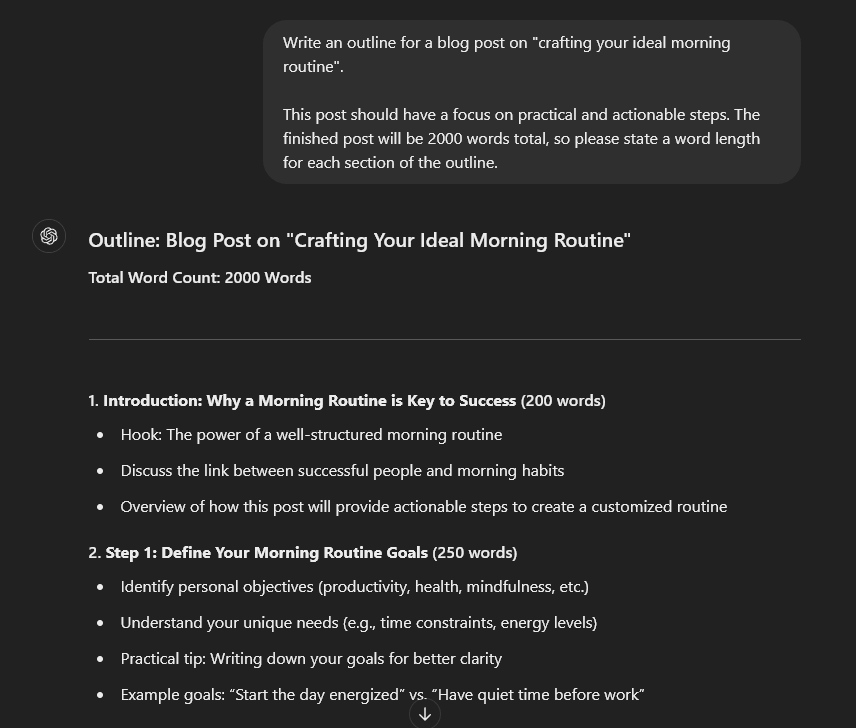

Pros of ChatGPT
- ChatGPT is completely free, for unlimited use. Play around with ChatGPT as much as you like and create thousands of words of content: you won’t ever have to pay anything.
- ChatGPT is incredibly easy to use. There’s no need to click around a list of tools or templates: just ask it for whatever you want, as if you were instructing a real-life AI assistant.
- You can use ChatGPT for all sorts of types of content—including poetry, fiction, scripts, computer code, personal letters, and more. It’s complex machine learning language models also mean you’ll be able to output content in just about any language.
- If a response isn’t quite right, you can get ChatGPT to rewrite it at the click of a button.
Cons of ChatGPT
- ChatGPT isn’t specifically designed for blog content, so you will probably need to use several different queries or a very deteailed prompt to produce a blog post. There’s no instant “recipe” for a full post.
- Some premium AI tools like Copy.ai draw on multiple different AI models, but ChatGPT always uses its own OpenAI model.
- If you want to be able to use the latest version of ChatGPT more than a few times a day, you’ll need to upgrade to the Plus version, which costs from $20/month.
Who is ChatGPT Best For?
If you’re on a really tight budget but you have plenty of time available, ChatGPT is probably the best option for you. You’ll need to do a lot more work yourself than you would with tools like RightBlogger… but you’ll be able to use ChatGPT to create unlimited content. Be prepared to experiment with different prompts and to ask ChatGPT to rewrite its output, as you might not get the results you expect the first time around. This is where mastering how to use ChatGPT can help get the most out of this tool.
Pricing
ChatGPT is free for unlimited use of GPT-4o Mini, and offers limited access to features like GPT-4o, o1, data analysis, file uploads, and web browsing.
The Plus version of ChatGPT costs from $20/month, or you can pay $30/user/month for the team version. API usage rates vary.
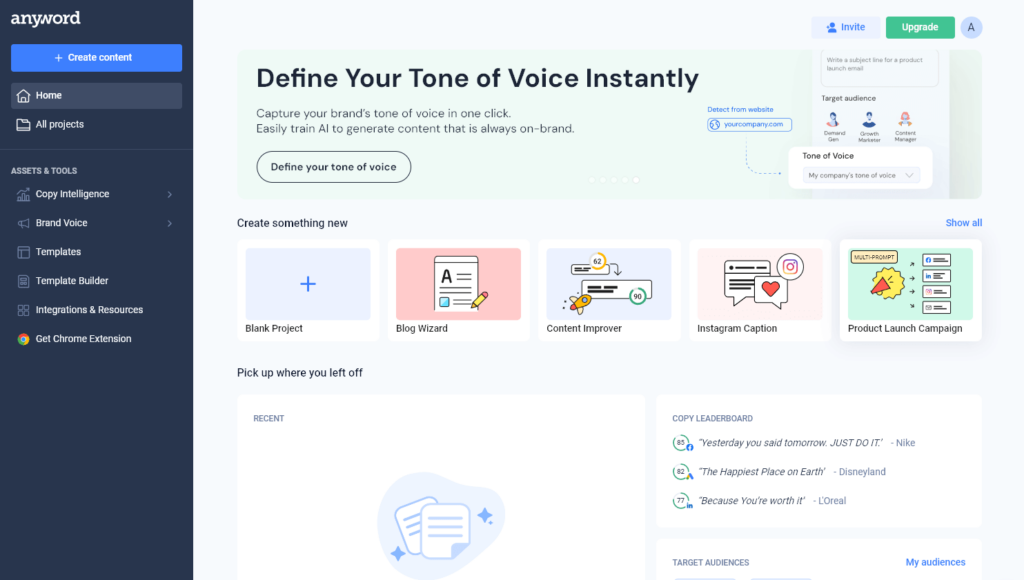

Anyword is aimed at large marketing teams and has a wide range of different AI writing tools as well as data-driven AI copywriting tools to help you create content and make more sales. Check out my primer on AI copywriting for more.
You can use Anyword to create landing pages, blog posts, Facebook ads, product listings, and much more. You can even use it for short pieces of content like email subject lines and for hyper-personalization.
Like many other AI tools, it has a “Blog Wizard” that produces blog content by first coming up with a title, then producing an outline and introduction before creating the full body of the content. There are also a whole range of other templates, plus the option to build your own templates.
Pros of Anyword
- The 7-day free trial doesn’t require a credit card, and gives you 2,500 word credits so you can try out Anyword.
- The blog wizard has the option to enter your SEO keywords for your post—something that most AI writing tools don’t offer.
- When the AI comes up with blog post titles, it automatically optimizes and scores them.
- While drafting content, you have the option to include extra instructions for the AI, such as “include statistics” (or you can simply go ahead and generate content for each section of your blog post).
- You can easily run a plagiarism checker on all or part of your post.
Cons of Anyword
- The Anyword interface can seem a little cluttered and overwhelming when you first start using it
- You only get one Brand Voice on the 2 lowest-priced plans.
- There’s no free version, only a 7 day free trial.
Who is Anyword Best For?
Anyword is a great fit for marketing teams who are looking to write a range of content as well as marketing copy (like ads and product descriptions). Small businesses and solo bloggers may find it pricy.
Pricing
From $49/month ($39/month when billed annually) which gives you unlimited copy, and 100+ templates.
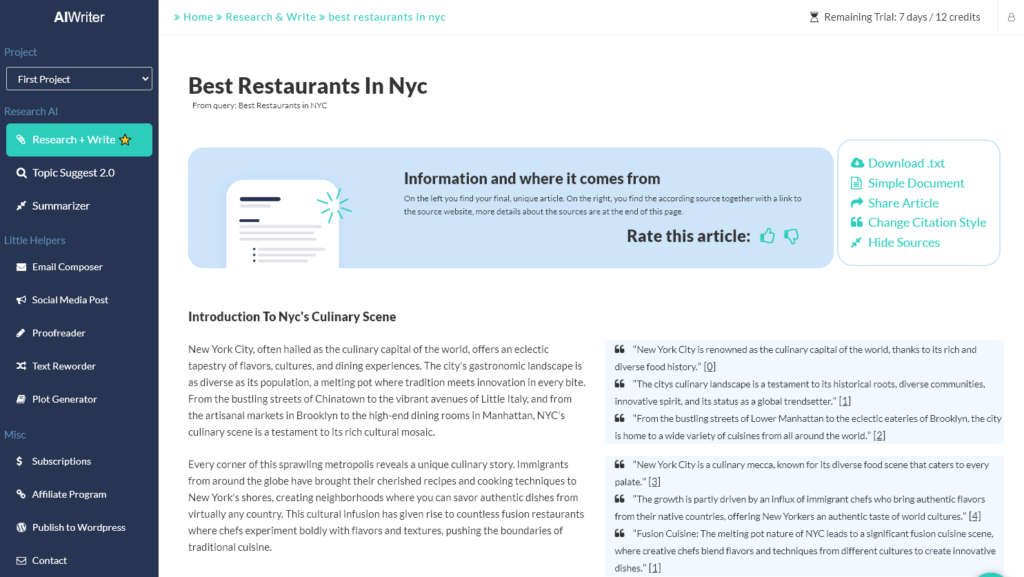

AIWriter can create blog posts or articles when you simply give it a title. It claims to be “the most accurate content generation platform”, though it isn’t particularly obvious whether (or why) AI Writer is any more or less accurate than other tools.
AIWriter is very much focused on writing blog posts: it produces these in one go, from a headline. This is fast and efficient, but means it’s much harder to fine-tune the results than with tools that produce more options for you to choose from.
Pros of AIWriter
- There’s a 7-day free trial that doesn’t require you to enter any credit card details.
- You can use the “Publish to WordPress” feature to quickly publish your content on your WordPress blog.
- There’s a built-in SEO editor that you can use for on-page optimization of your blog posts.
- For each paragraph it produces, AIWriter shows the source sentences and links to their origin, which lets you easily figure out where the AI got any facts or figures from.
Cons of AIWriter
- The blog posts produced will have subheadings, but they don’t include bold text or other stylistic features and will need quite a bit of editing to look visually appealing.
- You’ll need to create and activate an account to sign up for the free trial: you can’t use your existing Google account (which many other AI writing tools allow).
- AI Writer is really slow during the free trial, taking 1.5 minutes before even starting to work on each article. If you want to see results quickly or try lots of different inputs, then this isn’t the best AI writing tool for you.
Who is AIWriter Best For?
If you want to create well-sourced, accurate blog posts then AIWriter’s detailed listing of its sources will make it really easy for you to fact-check and to acknowledge sources where appropriate. However, the 40 articles/month will be more than many bloggers need, so the price is steep if you just want a weekly blog post.
Pricing
From $29/month ($24/month when billed annually) for up to 40 articles.
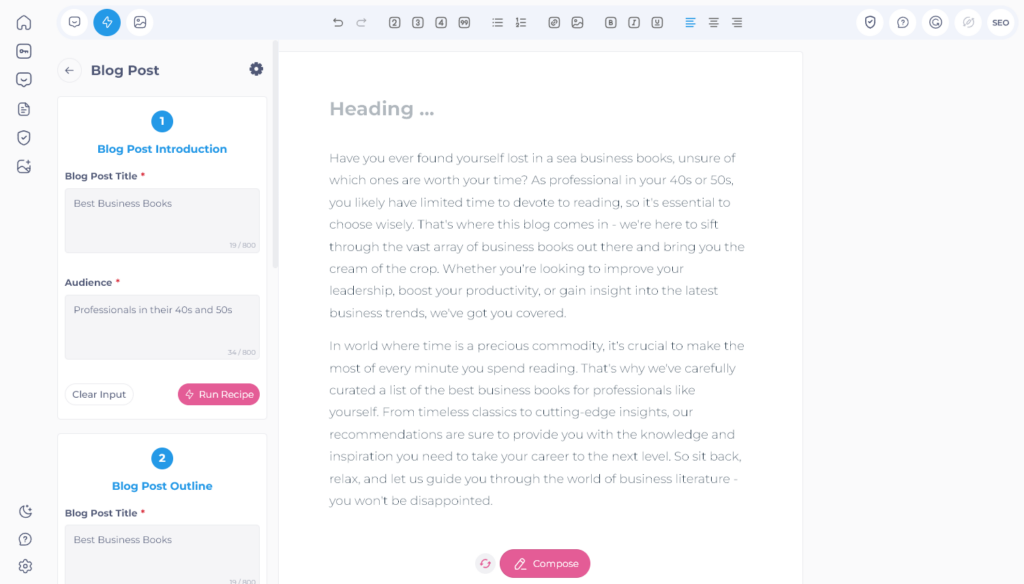

INK, formerly known as INK Editor, is a content creator that lets you produce both written content and images. You can either use it to write and optimize your content, or you can get it to do the writing for you. It also has SEO tools.
Like ChatGPT, it has a conversational interface, where you can ask it to do things like “Write a headline for my blog post about social media tips for small local businesses.”
It’s focused on writing sales copy and blog post content, so it doesn’t have frameworks for things like social media captions and other short-form content that many other AI content creation tools offer.
Pros of INK
- You can enter your primary keyword when creating content to optimize for that keyword, which means that INK Editor then prompts you to carry out specific tasks to optimize your content.
- INK Editor has a range of different features beyond just their AI writing tools, including keyword and SEO tools—you could potentially save money by using it instead of two or more different tools.
- You can create images as well as written content with INK editor, even on the free plan.
- The free plan lets you create up to 2,000 words and 20 images each month.
Cons of INK
- There were grammatical errors in the content produced when we tried INK (see the screenshot above for “a sea business books” instead of “a sea of business books”, “as professional in your” instead of “as a professional in your” and more).
- The free trial is only 5 days long. You need to sign up for the free trial before being downgraded to the free plan, which can be a bit confusing.
- Some aspects of the interface weren’t especially intuitive (or INK Editor didn’t understand the commands). After producing an outline for a post as requested, I then asked INK to “write a post based on that outline.” Instead, it produced an introduction for a different post—about choosing business insurance.
- The blog post generator requires quite a bit of information to create your post in stages (using “Recipes”) for the introduction, outline, individual paragraphs, and conclusion.
Pricing
INK costs from $49/month ($39/month billed annually)
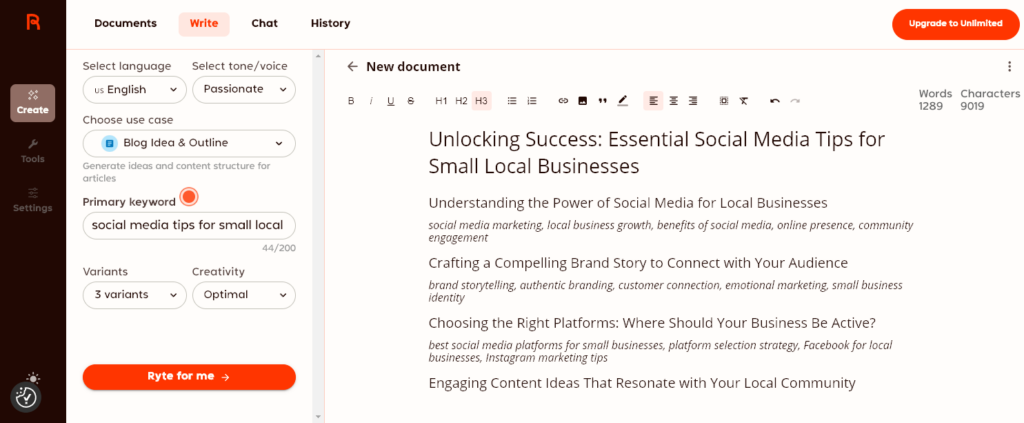

Rytr is a powerful but very budget-friendly AI content writing tool, with a clean and easy-to-use interface. Its free plan lets you create up to 10,000 characters of text per month.
You can decide how creative vs factual to make your text, and you can choose how many variants to create (one to three each time). Like many other AI content generators, Rytr will first generate blog post ideas and blog outlines for you, then you can edit this text before using Rytr to expand it into individual paragraphs and sections.
Pros of Rytr
- The free plan gives you access to 30+ languages and 20+ tones of writing, the same as the paid plans.
- On the paid plans, you can create your own “My Voice” for your content.
- You can select paragraphs or sections that don’t sound quite right and change the tone or length, improve them, or insert additional content. You can also use “Continue Ryting” to add another paragraph.
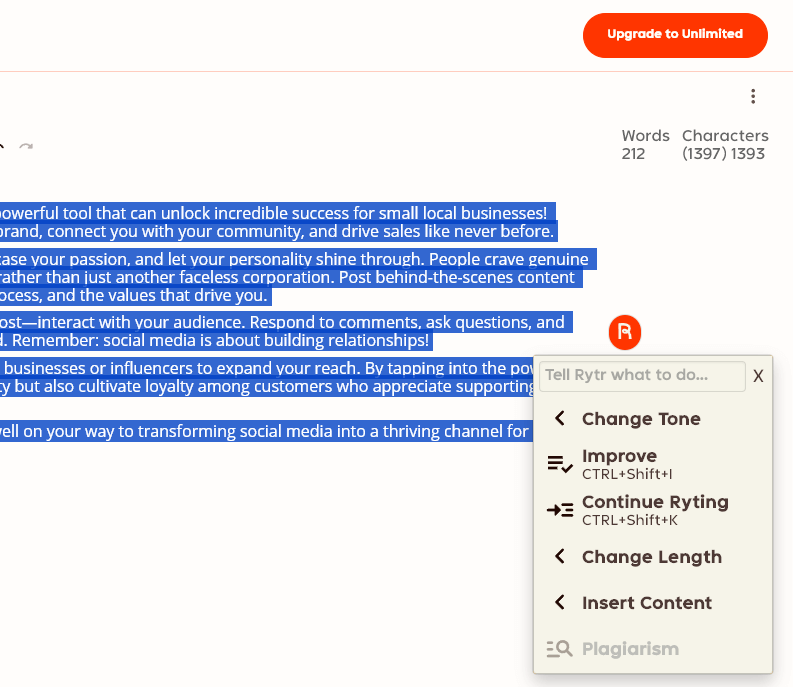

Cons of Rytr
- You can’t create a blog post in a single step: the interface can feel complicated at first
- The monthly credits on the free plan only allow you to create 10,000 characters (around one blog post)
Who is Rytr Best For?
Rytr is one of the cheapest AI tools on this list, so it’s a great option for small budgets. If you’re an individual blogger or you’re just getting your online business off the ground, Rytr is well worth a try.
Pricing
Rytr costs from $9/month ($7.50/month when billed annually), which gives you up to 100,000 characters of text per month.
Bonus AI Writing Tools to Consider (for Specific Use Cases)
The tools above are my top picks for AI writing alone. But if you’re looking for a more SEO-focused or editing tool, here are some quick bonus picks for you.


GrowthBar is designed to write content for blogs and websites, with a focus on SEO (search engine optimization). When you sign up, you’ll be prompted to enter your website URL, keywords that you want to track, and the URLs of your competitors’ websites.
Pros:
- Includes a 100% “no questions asked” money-back guarantee for 7 days after your first payment.
- GrowthBar offers a whole suite of tools, including keyword research, rank tracking, and a “site inspector” tool that lets you dig into details about your competitors.
- The AI writing editor is integrated with the SEO editor, making it easy to add keywords into your article as you edit.
Cons:
- You’ll need to do quite a bit of the work yourself when producing a blog post—e.g. you’ll be prompted to write an outline (or pick subheadings from competing articles).
- You’ll need to put in your credit card details in order to sign up for the 7 day free trial.
- If you want to pay monthly rather than annually, the prices are significantly higher.
Price: From $36/month ($20.30/month when paid annually), which gives you 25 AI content outlines and 500 AI paragraph generations.


Surfer, also called Surfer SEO, is designed for SEO optimization, and doesn’t actually write the content for you. However, if your main reason for using AI content writing software is to improve your articles’ Google ranking, it might be a great fit.
With the included outline builder, you can quickly and easily structure your content—the AI will generate subheadings for you (and will ensure that all content is unique).
Pros:
- You can connect Surfer with Jasper, if you’re using Jasper to create your content.
- Surfer also integrates with both Google Docs and WordPress to make it easier for you to write and publish blog posts.
- As you write, Surfer provides you with a real-time measure of your article’s optimization (shown as a numerical score out of 100).
- Sufer includes AI detection (though personally I think there’s good evidence that AI detection doesn’t work) and the option to “humanize” AI text to improve it
- There’s a built-in plagiarism detector, which can be reassuring if you’re using AI content generation, or if you’re editing an article written by someone else.
Cons:
- You can’t use Surfer SEO to actually write the content for you—though its AI writing tools could certainly help speed up the writing process a lot.
- There’s no free trial—though you could potentially sign up and then request a refund within the 7-day refund period.
Price: From $89/month ($69/month when paid annually), which lets you write and optimize up to 30 articles per year.


Frase is another AI writing tool that offers help with SEO-friendly content generation. You can use it to create new content or you can optimize content that you’ve already created. Frase helps you to come up with an outline for your content, based on competing articles.
Once you have that outline, you can click a button to get Frase to “write about this” for each section, or you can write these sections yourself. You can also use the AI writer to create your whole article.
Frase also makes use of NLP (Natural Language Processing) to assist with search engine optimization.
Pros
- Frase is a budget-friendly option if you only want to produce a few blog posts each month.
- You can get the Pro add-on to include extra features, including unlimited access to the AI writer, for an extra $35/month.
- Frase now uses the OpenAI model which produces better quality content than Frase’s in-house AI model.
- Frase lets you create SEO briefs (e.g. for a copywriter)
Cons
- The free trial only gives you the ability to create and optimize 1 article.
- While you can create a brief, you’ll still need to select your title and outline sections.
- You can ask for a full article, but there’s no easy process to create an outline, then create the article in a click or two.
Price: From $15/month ($12/month if paid annually) to create and optimize up to 10 articles/month.


Article Forge writes unique, search engine optimized articles—and even offers bulk article generation, which could be useful if you need to come up with a lot of SEO content for your website. Its content will pass Copyscape requirements (which means it avoids plagiarism) and you can use it to create long articles of 1,500 words without needing to approve outlines or take lots of extra steps.
Pros:
- When customizing your article’s structure (before running the AI generator), you can choose topics to exclude.
- You can choose different article lengths, from around 50 words to around 1,500 words.
- Article Forge can include extras in your article, like an image or video. It can even automatically post articles to your WordPress blog.
- Article Forge is quite a bit cheaper than many competing tools, especially if you pay annually.
- There’s a 30-day “no risk” money-back guarantee—though note this only applies if you use Article Forge to create fewer than 10 articles.
Cons:
- The free trial is only 5 days long and you’ll need to enter your credit card or PayPal information to access it.
- Article Forge takes a couple of minutes to produce each article: quite a bit slower than some other AI tools, which give a near-instant response.
- If you want to pay monthly, you’ll need to pay twice as much overall, compared with the annual fee.
- The image chosen by the AI may not be a particularly good fit for your article.
Price: From $27/month ($13/month when billed annually) which gives you up to 25,000 words/month.


Although Grammarly won’t write your content for you (yet), its impressive AI editing tools mean that it can offer a huge amount of re-writing help. This isn’t just limited to checking for spelling and grammatical errors—Grammarly will advise you on style, tone, and more.
If you’re using a different tool to produce blog posts, you might want to run them through Grammarly to help you edit and improve them.
Pros
- There’s a full free plan for Grammarly, with no usage restrictions. (This doesn’t give you access to Grammarly’s more advanced features, however.)
- Grammarly will rank your writing according to different criteria, such as correctness, clarity, engagement, and delivery.
- You can install Grammarly on your computer to use it in apps, word processors, email clients, and more, which could help streamline your editing process.
- There’s a built-in citation generator to format citations in APA, MLA, or Chicago style—useful if you’re including a lot of references in your blog posts.
- Grammarly explains why it’s recommending a particular change: perhaps because you’d written something incorrectly, or because you were too wordy.
Cons
- Grammarly isn’t an AI content writer as such, so it won’t actually produce content for you.
- The free version is quite limited and mainly includes spelling and grammar corrections, along with a few indications of places where you’ve been too wordy.
Price: From $30/month ($12/month when billed annually).
15. WordTune


WordTune is a rewriting tool: as with Grammarly, you could use it to improve text that you’ve produced with an AI content writer, or you could use it to rework an article you wrote yourself.
As well as the rewriting feature, WordTune offers a “summarizer” to create a short version of long documents—helping you to take in information more quickly. WordTune also has the option to shorten and expand passages of text, which could be useful if you’re repurposing content for a different medium.
Pros:
- You can try out WordTune instantly and for free, just by posting a small sample of text into the box on their homepage. This will offer several different rewrites.
- WordTune integrates with Google Chrome (and other browsers) so that you can use it on various websites.
- You can stay on the free plan for as long as you want, though keep in mind that it only offers 10 rewrites per day. and 3 AI summarizations per month.
Cons:
- The monthly plan will cost you 60% more across a year than the annual plan.
- You can’t use WordTune to create completely original content, only to paraphrase (or shorten/expand) content that you already have.
Price: From $13.99/month ($6.99/month when billed annually), which gives you unlimited access to the AI paraphrasing tool (and the ability to rewrite full paragraphs).
3 Common Questions About AI Writing Tools
We’ve run through lots of great AI writing tools that could bring you new inspiration, help you create content faster, and improve your writing. But you might still have some questions or concerns about using AI writing tools. Let’s clear some of those up now.
Is it Cheating to Use an AI Writer?
Writing blog articles, social media posts, landing page copy, or other online content using an AI writer isn’t cheating. Plenty of bloggers use ghostwriters to create content for them or pitch in at various stages of the writing process (myself included), perhaps lightly editing this content before putting their own name on it: what you’re doing with an AI writer isn’t much different.
If you’re a solopreneur or a tiny startup, using an AI writer could help you compete on a more level playing field with much larger businesses.
Of course, there are some situations where using an AI writing tool might be considered cheating. If you’re working on an academic paper, for instance, it’s likely that your university will prohibit the use of AI tools (just as they’d prohibit the use of a ghostwriter).
Are AI Writing Tools Bad for SEO?
AI writing, on its own, is no better or worse for your blog’s SEO (search engine optimization) than content that you write yourself.
However, many AI writing tools include built-in SEO support. For instance, at a very basic level, you could give the tool a keyword and it’ll include it in all your blog post title variants. Some bloggers don’t remember to do this (or don’t realize how crucial it is for SEO) … meaning that AI writing might actually be better for SEO than writing the piece yourself.
It’s important to edit the content that your AI tool produces, using SEO best practices to make sure that it has a good chance of ranking well. You should also edit for readability, voice, tone and matching your writing style.
How Do I Use an AI Writing Tool?
The best way to get started with any of the AI writing tools above is to sign up for a free account. Try out the tool with a simple prompt, like a blog post title or a request for an outline.
If you have the option to enter extra information (like keywords, or the tone you want), then do so: the more information you give to the AI, the better your results are likely to be.
Don’t simply publish the content that the tool produces, however good it looks at a glance. You’ll need to read through carefully, double-check any facts or statistics, and spend some time optimizing your post for SEO in order to produce truly high-quality content. Some AI writers will include subheadings for you, but if your chosen tool doesn’t, make sure you add these to help break up your post.
Many AI writing tools learn about your style and preferences over time, so once you’ve found a tool with the key features and functionality you need, stick with it. That way, you’ll hopefully find that the content it produces requires less and less editing over time.
The best way to view AI writing is as a collaborative process—not one that fully replaces human writers. You give the tool a starting point or idea, the tool comes up with some rough content for you, then it’s your job to shape that content and turn it into something that’s uniquely you.
Get Creative Using AI Writing Tools Today
Are you ready to give AI content writing a go? Whether it’s something you hadn’t even considered before today—or something that you’ve been interested in for a while now—it’s really easy to get started.
Nearly all the AI writing tools I’ve listed above offer some kind of free trial, so pick one that you like the sound of, and create some unique content using it. And I also have a free AI paragraph rewriter tool you can use too.
Don’t forget, you’ll need to give your blog post a great headline (if my blog title generator tool hasn’t done that for you!) and you’ll want to allow enough time to edit the content so that your blog post is a strong fit for your brand and style.
Need some more help writing engaging blog posts? Check out my tips on writing a blog post that people will actually want to read, which includes a blog post template and step-by-step tutorial.
Try RightBlogger: My 80+ Hand-Crafted Tools for Content Creators


Join 10,397+ creators, bloggers, marketers, writers, freelancers & entrepreneurs in using my very own kit of powerful tools for content creation: RightBlogger. You’ll unlock 80+ blogging, SEO, marketing, sales and productivity-focused tools to create content faster & more effectively today.

